Designers: Stamp Walden and Jason Wright
INTRODUCTION
Our client Emily (pseudonym) is an athlete with Myelomenigocele Spina bifida, which over the years has worn away the cartilage in her hips. She uses a manual wheelchair as her primary source of transportation, resulting in excellent upper body strength and range of motion. She can stand and walk, but she easily tires if she is standing for a minute or two. While standing, she is not able to pick up heavy objects.
Emily is an accomplished kayaker, having competed at the Paralympic level. She has a 17 foot, 32 pound, carbon fiber kayak and a practice location that requires her to drive with the kayak from her home to the launch spot. However, she is not able to transport the kayak on and off the roof rack of her van, and to and from the water. As a result, she needs assistance both at home and at the launch site when she wants to go kayaking. For this project, we have modified a commercial roof rack (figure 1a) to enable Emily to load and unload the kayak from her van by herself. We have also designed a cart (figure 1b) that helps her move the kayak between her van and the kayak’s storage location at home, and to and from the water at the launch spot. Both the rack and the cart are safe and resistant to the harsh elements associated with kayaking including high humidity, moisture and sand.
STATEMENT OF IMPACT
As a competitive athlete, our client wants to be able to train without needing help from her friends and family. Our client’s passion is to be active and independent. With the Port-O-Yak, our client is able to load her kayak on her van, take it to the launch location, unload the kayak, and go out on the water. After some time on the lake, she can reverse the process. When we asked her about the impact of this project, she replied, “This is simply going to be amazing”.
TECHNICAL DESCRIPTION
Our design exists in two parts, a kayak rack and a cart. The rack is designed by modifying a Thule Hullavator rack. The cart is designed to transport the user and kayak to and from the water. She can propel the cart by sitting on the attached seat and pushing on the ground with her feet.
A. Extending Rack
The purpose of the extending car rack is to lower the kayak from the roof of the van to a level where Emily can access it from her wheelchair. It was made by modifying a Thule 897XT Hullavator, which attaches to Thule basic square bars that fit onto the factory tracks that came with our client’s van. The Hullavator rack rotates the kayak down to the driver side of the car. In order to further lower the kayak, we constructed a custom sliding mechanism. The sliding piece is comprised of 1.5’’ H aluminum bar that was ground down to 0.85’’ on one side. The shorter side fits snuggly in the track on the top of the Thule Hullavator. The H bar has a 0.5’’ bridge that provides the stiffness to allow the slider to hang below the commercial rack without it flexing or swinging. The H bar holds the rack cradle, pins and safety hardware. Spring loaded pins are attached on each aluminum H bar in order to allow for the sliding extender to stay locked in place until the user is ready to fully slide down the new extension. As an extra precaution against unexpected release during road travel, we added a universal 0.75’’ cotter pin that gets placed through the extender and the commercial rack to hold them in place. We attached rubber pads to the back of the Hullivator to protect the side of the van when the rack gets lowered to that position. After the full extension process and once the sliding H bars have been released and eased down, the kayak is then ready to be unstrapped and rolled onto the cart.
B. Cart and Cradle
The cart is designed to support our client, the kayak and 50 lbs. of gear. The steering tiller and back chassis system is from a commercial garden pull cart. It has four 13’’ inflated rubber wheels, tested to 500 lbs., that allow the cart to firmly roll over the rough terrain. The back of the cart is fitted with a light plastic seat, a steering tiller, and a brake lever. The seat is situated to the right of the kayak and fully supports the user over the back wheels near the steering tiller. An aluminum brake lever with a rubber stopper pushes against the back right wheel for braking. On the left side of the cart, the kayak fits into a custom built cradle. The cradle is made from four 3’ curved aluminum tubes. Each section is made from ¾’’ aluminum tubing with a ¼’’ side wall. They are all bent to fit the shape of the top and bottom of the kayak. This allows the kayak to sit on its side with the bottom facing away from the client. All aluminum tubing is coated in 1’’ rubber insulating tubing to protect the kayak from bruising on the metal.
The cart is built in two pieces for easier storage in the back of the van during transport. The rear chassis is a U shaped aluminum square bar of 1.5’’. To assemble the cart, the user slides the two prongs of this U directly over the 8’’ steel prongs that extend from the back of the front chassis. It is held together with 5’’ standard safety pins. The cart’s total length is 3’ and its total width is 16’’.
The total cost of the rack and cart was $386. This includes the cost of a used Thule Hullivator rack for $100, but the client purchased the Thule square bars separately.

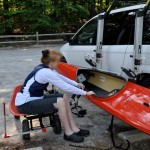
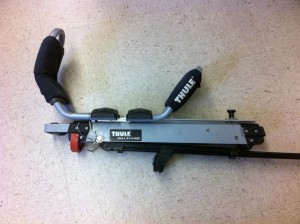
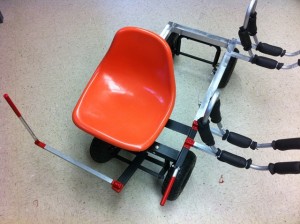
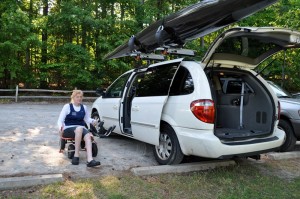
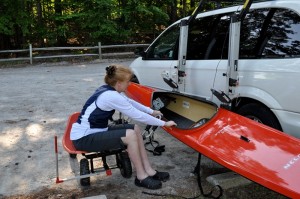

2 Comments
Well done guys. I’m sure she appreciates it. As relative of an individual with Spina Bifida I understand the daily struggles. I applaud your client as well for being proactive and doing want she enjoys regardless of the obstacles.
Also, from the pictures it looks very well made.
Hi Guys,
For sure Emily is very happy by now, do you have any updates or more pictures, did you mange to get more clients?, It’d be great to know if you managed to scale this in a real business, there are a lot of people with Spina bifida, it is great what you are doing!
Regards,
Roxanne – Crissy’s Friend 🙂
PPI & Law Student (College)